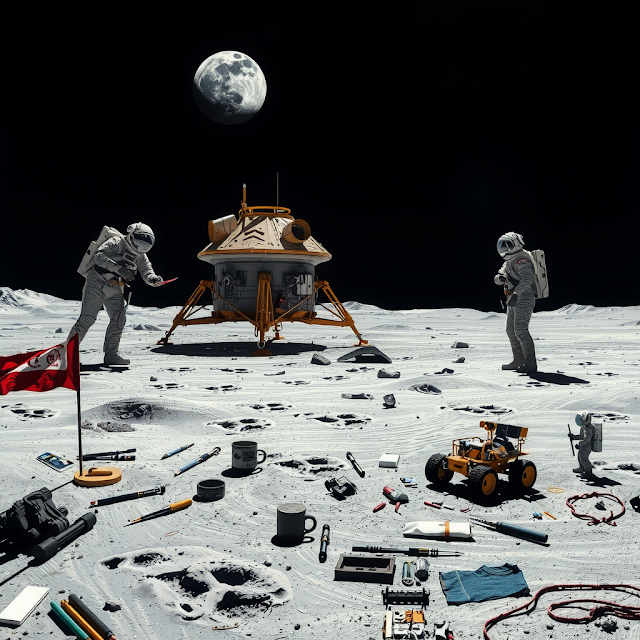Space Archaeology: Preserving Celestial Treasures
When I heard most people’s idea of archaeology, it only involved ancient cities, pottery, and relics, but modern archaeologists have a new frontier to explore beyond the earth’s atmosphere; space archaeology. In this new discipline, experts seek to understand and safeguard artifacts of human exploration beyond the planet Earth.
Understanding Space Archaeology
Space archaeology entails studying the artificial structures existing in outer space. These include satellites, spacecraft, lunar landers, and even footprints left by astronauts on the moon. Just like traditional archaeology, the goal is to ensure that we preserve spaces history by studying the remaining artifacts, only this time we are dealing with history beyond Earth.
Space Archeology And Its Importance
The exploration of space is perhaps one of the most remarkable feats accomplished by humanity. The launch of the Sputnik in 1957 was simply the beginning for what would later give rise to the Apollo moon landings and the international space station. All these missions are very much bound to leave a mark in one way or the other and the objects left behind are not mere junk. They are space artifacts symbolizing human potential, scientific achievements, and collaborations between different nations.
Robotic satellites have also changed the way we view other celestial bodies, not to mention the ground-based telescopes which have put astronomical wonders in clear focus.
All of these objects tell a narrative that highlight the need and value of preserving our space heritage:
- Historical Importance: These relics represent man’s firsts steps into the outer space.
- Scientific Insights: Researching older satellites and spacecraft reveals the technology and materials of space missions from the past.
- Cultural Significance: Space exploration is a remarkable achievement of mankind that transcends geographical frontiers and brings people together.
What Are Space Artifacts?
Artifacts from space contain anything that humanity has launched outside the Earth’s atmosphere. A few examples are:
- Satellites: Consist of communication satellites, meteorological satellites, GPS satellites, and others.
- Spacecraft: Includes the Apollo lunar modules, Mars rovers, and Voyager probes.
- Space Stations: Parts of the International Space Station as well as its predecessors like Mir.
- Personal Items: Tools used by astronauts, flags, and even a lunar golf ball.
Some of these objects remain in orbit, while others are located on the Moon, Mars, or other celestial bodies.
The Challenge of Space Debris
The most difficult problem of space archaeology is the great volume of satellite debris orbiting the Earth. NASA tracks over 27,000 pieces of space junk, from abandoned satellites to small flecks of paint. While some of this debris is historically valuable, much of it poses risks to current and future space missions.
Balancing the strategies for maintaining significant space artifacts and keeping outer space accessible for movement is one of the core challenges facing both space archaeology and policy-making.
What Methods are Used in the Preservation of Cosmo Archeology?
Unlike the boundaries of Earth where one can simply create a perimeter to protect places of interest, space is all encompassing and as such extremely difficult to set borders of human constructs, particularly because there are numerous locations filled with artifacts which are located in very unforgiving terrains. Below are some methods space experts are using to protect humanity's heritage as far as space is concerned:
1. Tracking and Recording
Artifacts in space can be spotted and recorded using telescopes, radars, or even satellite imagery. Space researchers in claim that they have created maps detailing the particulars in tracks of lunar landing sites, forsaken satellites, and assorted other objects orbited around Earth.
2. Space Treaties
There are louder voices calling urgently in the international sphere for agreements that work towards allotting deserts in space special protected area zones akin to the Nothing Zones on Earth. By now the Moon landing site of Apollo 11 is regarded as a heritage site by an ever growing pool of people. Some organizations have already started to push for treaties that would protect landmarks from being destroyed by future missions.
3. Satellite and Spacecraft
In other cases, space missions are purely planned in order to study or even remove artifacts in space, such as Japan’s Hayabusa which went to space with the goal of collecting samples from asteroids, or NASA’s OSIRIS-REx which plans to retrieve chunks out of asteroid Bennu. These missions let scientists examine the impact of space on different materials while also
In safeguarding our space heritage, we also remember those who had the courage to dream beyond Earth while fostering aspirations for future explorers.
Finally
The very space archaeology you know is a pretty important field that tells, tracks, and in many ways, protects the story of humanity’s exploration into the universe. The ongoing exploration and colonization of new worlds will necessitate an even greater reliance on remembering our origins and where we have embedded artifacts.
It is our responsibility to protect and celebrate modern space artifacts, ensuring they inspire universal awe and respect. For everyone: scientists, students, space enthusiasts, or citizens, the work of space archaeologists offers a seamless link to the past, while enabling us to glimpse a hopeful future in interstellar realms.




















No comments:
Post a Comment